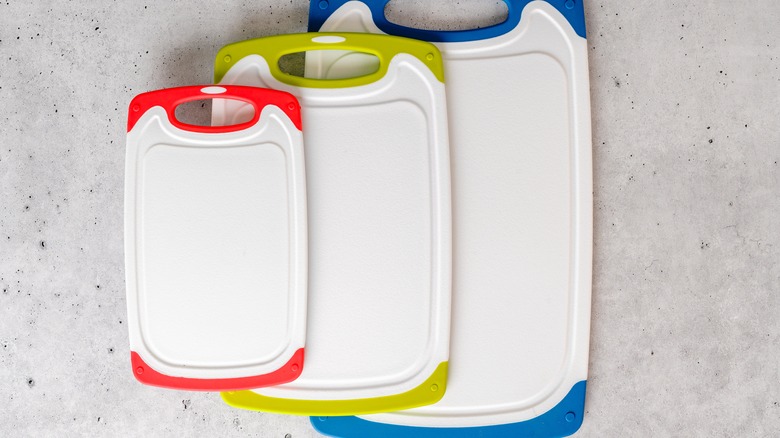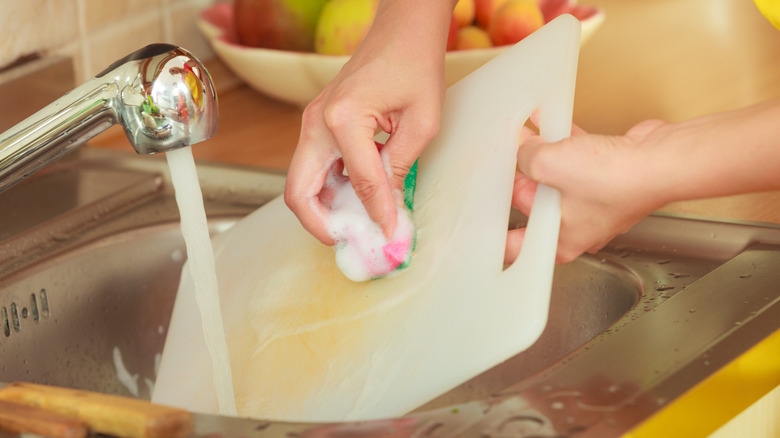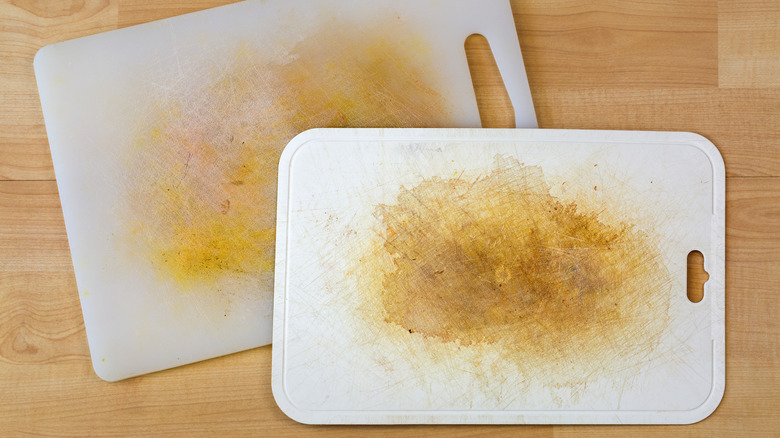How To Properly Clean That Dirty Plastic Cutting Board
Keeping your cutting board clean is an important way to prevent cross-contamination from different foods. If harmful bacteria latch onto the board, it could spread to other foods and even make you sick. Fortunately, thoroughly cleaning your cutting board can rid it of bacteria and keep the board safe for use. Different kinds of cutting boards require different cleaning methods. When using plastic cutting boards, a quick clean could be pretty simple, but a deeper clean may require a little extra work.
After every use, you'll want to clean your plastic cutting board with warm water and dish soap. Give the entire surface a good scrub, making sure to concentrate on any divots where food or bacteria could be hiding. Then, rinse the entire thing and allow it to dry. For some extra sanitization, many thicker plastic cutting boards are dishwasher safe and can be sanitized along with your other plates.
While hand washing is recommended every time you use the board, don't make the mistake of forgetting to deep clean the board to prevent bacteria buildup.
Deeper cleans are important for killing bacteria
While plastic cutting boards start off smooth and non-porous, knives can wear them down over time and scratch the surface. Those scratches can create spots for bacteria to hide, so deep cleaning is essential if the surface is scratched.
If you want a deeper clean after every use, you can mix a little bit of bleach into some water. Two teaspoons of bleach per every gallon of water is the recommended ratio, per Clorox. Then, you can either use a sponge to wipe down the cutting board with the bleach mixture or allow the cutting board to soak in the liquid for around two minutes. Both methods will sanitize it and kill any lingering bacteria. Rinse the board with hot water after it's finished soaking, and allow it to air dry.
Still, even clean cutting boards can take on stains from foods chopped on them. Fortunately, if you aren't quite ready to replace your old cutting boards, there are ways to remove those stains and leave the boards looking as good as new.
How to remove stains from plastic cutting boards
There are two methods that work especially well when removing surface stains and odors. The first involves mixing hydrogen peroxide and baking soda with dish soap into a paste. Once they're mixed together, the paste can be spread over the plastic cutting board and left to rest overnight. Then, it can be rinsed with warm water and allowed to dry.
The other method adds white vinegar and a little bit of salt. The board should first be soaked with white vinegar or hydrogen peroxide and allowed to rest for a few minutes. Then, wash it with dish soap and warm water. While the board is still wet, make a salt and baking soda paste with a little bit of water. Although it may require a little bit of extra effort, scrubbing the board with this can quickly remove stains.
While you may be content to quickly wash your plastic cutting board after every use, make sure you also take the time to give it a deep clean to prevent and remove stains, kill bacteria, and prolong the life of the cutting board.


